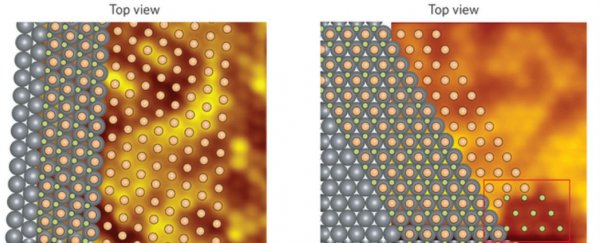Scientists have been theorising about its existence since 2013, but now it's finally here in physical form: stanene, an intriguing new material made up of a one-atom thick mesh of tin. Just like its much-hyped cousin, graphene - which is made of one-atom thick layers of carbon - computer models predict that stanene could conduct electricity without heat loss.
In fact, theories predict that stanene could be the most efficient material ever made when it comes to conducting electricity. Being two-dimensional, the material allows electrons to zoom along the edges of the mesh in a single lane, bypassing the energy-sapping collisions that occur in three-dimensional materials to achieve 100 percent efficiency. And theoretically, it should work at room temperature.
"It's surprising that it can work at such a high temperature," one of the team, physicist Shou-Cheng Zhang from Stanford University in the US, told Charles Q. Choi at Scientific American back in 2013. "Scientists have looked for dissipationless transport of electricity for many years, but usually the systems we find only work under extreme conditions, either very low temperature or strong magnetic fields."
Because stanene could potentially allow electrons to travel uninterrupted - collisions cause vibrations that generate heat and result in energy loss - wire made from this new material could carry electricity across great distances for long periods of time without energy loss. Imagine your smartphone, laptop, and chargers working for hours without ever getting hot.
If stanene lives up to the predictions that it can work at room temperature with 100 percent efficiency, it will be the perfect example of a topological insulator, overtaking graphene as the best new material to build the electronics of the future.
But that's a big "if". So far, the team that produced the material has not been able to confirm that stanene has any of these properties at all, and the problem lies in the way that Zhang and his colleagues constructed it.
"The researchers vaporised a bit of tin inside of a vacuum chamber, allowing it to form its characteristic mesh on a bismuth telluride surface," a university press release explains. "The team was able to see only the top ridges of the structure with a scanning tunneling microscope, however, and believe the substrate interacted with the mesh, preventing conductivity testing."
Physicist Ralph Claessen from the University of Würzburg in Germany, who was not involved in the study, told Chris Cesare at Nature Magazine that he's not even sure that what Zhang and his colleagues produced is actually stanene, because the entire structure of the tiny sample can't be seen in its entirety.
Back in 2013, theories predicted that stanene's two-dimensional tin lattice would form what's known as a buckled honeycomb structure, which must include "alternate atoms folding upwards to form corrugated ridges", says Cesare. Right now, Zhang and his team can only see the upper ridge of these alternating atom, which means they cannot confirm that it is a true buckled honeycomb structure, but they told Nature Magazine that the distance between the ridges they can see correspond to what a buckled honeycomb structure should look like.
There are a couple of options going forward, the team can work with the tiny sample they have now, and try confirming its structure using X-ray diffraction. Or they can work on producing a larger sample so the arrangement can be more easily seen. Then they will have to figure out which materials can be used instead of bismuth telluride so they can actually perform conductivity testing. The team has summarised the findings in Nature Materials.
We're not there yet, but it's a start, and that's exciting enough in itself, says graphene expert, Guy Le Lay, from Aix-Marseille University in France: "It's like going to the Moon. The first step is the crucial step."
